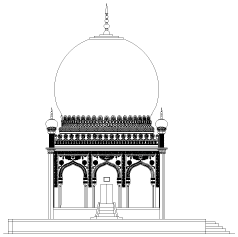- Fort Rd, Toli Chowki, Hyderabad, Telangana, 500008, India
- Visit
Explore the Qutb Shahi legacy, learn from the past, and enjoy a leisurely escape in this beautifully restored heritage site.
The transformation of the Qutb Shahi Heritage Park through conservation and landscape restoration by the Aga Khan Trust for Culture, in partnership with the Department of Heritage Telangana, has made it a vibrant cultural destination. The necropolis is not only a historical treasure but also a flourishing urban space for Hyderabad's residents and visitors alike.
The Conservation and Landscape restoration effort, which began as a Public-Private Parternship in 2013 with the signing of an MoU between the Aga Khan Trust for Culture, the Department of Heritage Telangana, Government of Telangana, and the Quli Qutb Shah Urban Development Authority, is the largest conservation undertaking in India, at present. It is expected to result in a site that will attract several million visitors to Hyderabad, especially when combined with the opportunity to visit the adjoining Golconda fortification.


“The concept of public-private partnership is an essential keystone for effective cultural development…The role of governments, including municipalities, is fundamental in providing what we often term “an enabling environment” for development”.
This royal necropolis stands as a unique kaleidoscope of Qutb Shahi architecture, spanning the entire dynasty's reign. Grand mausoleums, numerous funerary mosques, Baolis (stepwells), enclosed gardens, and gravestones fill the 106-acre complex, each structure reflecting a distinct and striking architectural style. With over a hundred structures, the necropolis, along with the Golconda fortifications, forms an unparalleled ensemble of outstanding universal value. The monuments, including the mausolea set within formal gardens and adorned with intricate stucco patterns, represent an archaeological zone unmatched anywhere else in the world.
The AKTC-led conservation and landscape restoration project at Qutb Shahi Heritage Park aims to ensure the long-term preservation of this unique heritage, reflecting the original builders' vision. It is anticipated that the restored necropolis will lead to a significant increase in visitors and tourists, fostering local pride and creating potential economic opportunities.
Combining conservation with a landscape scheme at the setting of these monuments, this project employs the AKTC's historic city center approach, successfully used in cities like Delhi, Cairo, and Kabul, amongst others. This methodology, adopted by UNESCO in 2015, emphasizes a crafts-led conservation process, generating employment for craftspeople and improving the quality of life for local communities. The project serves as a model for inclusive conservation, garnering support from civil society, officials, and private agencies, and promoting conservation funding through CSR initiatives.
This public-private partnership aims to demonstrate the rationale of conservation efforts, aligning with government and local development objectives.

The conservation works at the Qutb Shahi Heritage Park, led by the Aga Khan Trust for Culture (AKTC), adhere to international norms and charters, as well as the ASI national policy, relevant to the Indian context. Following respected practices, our primary aim has been to conserve, stabilize, or consolidate all original structural elements and ornamentation that can be salvaged or repaired. In cases where the original character, such as the glaze on tiles, has been lost, we have used traditional materials and building techniques for any necessary replacements or new additions.Traditional craftsmen have played an integral part in the conservation approach at the Qutb Shahi Heritage Park, and from the onset, the project has followed a ‘craft-based approach’. The project has included a significant training component aimed at making craftsmanship sustainable.
The project’s approach is to enhance cultural significance while minimizing alterations. This principle is crucial, especially when addressing 20th-century changes that were not aimed at conservation and do not constitute a ‘historic layer.’ These changes are undone to accurately interpret the 16th and 17th-century layers. Restoration and even reconstruction are sometimes necessary to halt deterioration and ensure a true understanding of the structures.
The landscape master plan, informed by site surveys and archival materials, enhances the setting for the monuments, improves rainwater collection in step-wells, and optimizes visitor circulation. Distinct ecological zones, featuring native tree species, are being created in the necropolises northern and southern sections. Ecological trails aim to serve as a green buffer and provide educational experiences about Hyderabad's heritage and ecology.
The AKTC-led project at the Qutb Shahi Heritage Park meticulously restores over 100 monuments from the 16th and 17th centuries, ensuring their long-term preservation. This includes the landscape development of the 106-acre necropolis. This lush landscaping complements the historical significance, creating a heritage park of international stature.
The restored Heritage Park will become a source of immense pride for Hyderabad's residents and a major tourist destination. This influx of visitors will translate into significant economic opportunities for local communities.
Beyond cultural preservation, the new green spaces offer environmental benefits and raise awareness among citizens. Educational opportunities and improved access to this beautiful space will enhance the quality of life for local communities. This conservation-led development, through education, economic opportunities, and access to a well-designed green space, will improve the quality of life for local communities in the immediate vicinity and the greater Hyderabad region